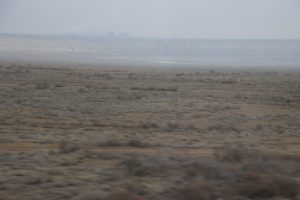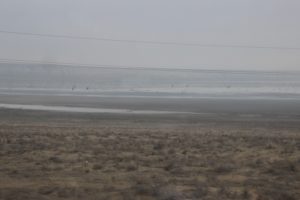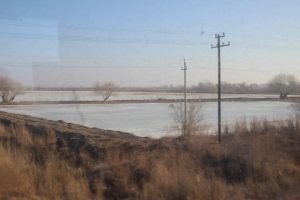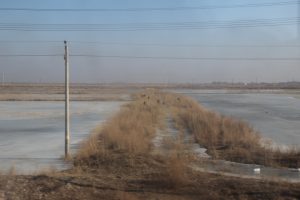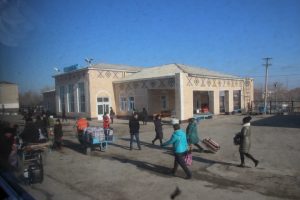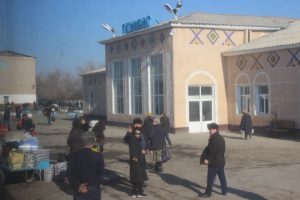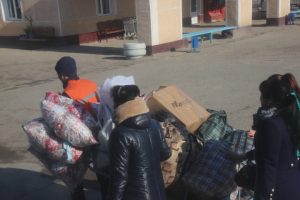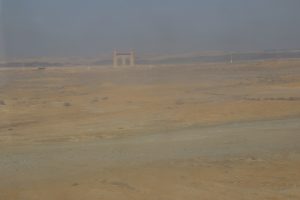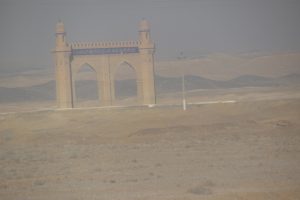The formalities of border crossing made us forget that it is really Thursday though again sleep meant that we missed the end of the Steppe and the beginning of the desert.
We could have slept longer but around 10:00 we were woken by what seemed like an army of itinerant traders selling food, drink, clothes, toys, perfume, phones and most importantly the money changers. It is called the Black Market but the wads of notes are wrapped in official bank wrappers and in a minute 100US$ is changed into tens of thousands of Uzbekistan som. The desert is now widespread with lots of evidence of salinisation and the receding Aral Sea. The Aral Sea is fed by two major rivers, the Syr-Darya and Amu-Darya, which flow roughly west and northwest from the region of central Asia where the Pamir, Tian Shan and Himalayan Mountain ranges collide. In the 1950s the Aral Sea covered about 67,000 sq.km and was up to 400km north to south. Fishing fleets operated from a town not far from our railway track at Moynaq and even passenger ferries crossed it. All this unfortunately changed as Soviet planners saw the boosting of cotton production in the republics of this region as a means of improving standards of living in the republics and the textile industry. This demanded the use of the river’s water but, as many of the fields were on poorer desert soils and fed by unlined canals open to the sun, evaporation was a major problem which was solved by extracting more water. The effect all this had is evidenced today by the shrinking Aral Sea and the migration of more than 60,000 people who were involved in the fishing industry alone. This turned the fishing industry into a relic of the past. Today fishing boats are left high and dry surrounded by desert. The impact on humans is only one of the impacts that the irrigation schemes have had. It is thought that the Aral Sea and its surroundings had more than 150 different animal species but today it maybe only one-fifth of that. As the Aral Sea was so large, like the Great Lakes of the USA and Canada, it affected the weather and climate of the region. This continues but the effects are different. The air is drier, the winters are colder and longer and in the summer it is much hotter. Every year some hundred thousand tons of salt and sand from the now exposed bed of the sea is blown many kilometres in sand storms which also pick up the residues of fertilisers and even some biological warfare chemical’s remains. This clearly has an impact not only on the land but on the remaining people.
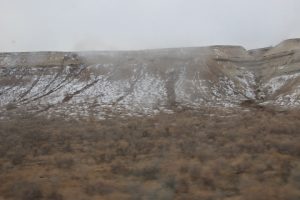

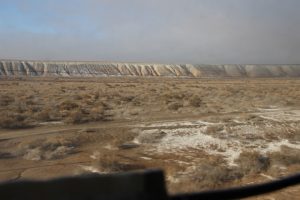
Our journey continued along the floodplain of the Amu-Darya with lots of small farms with lots of evidence of rice production.
We finally arrived in Urgench at 18:30 having travelled through the Amu-Darya delta. This region is where the river breaks into many branches called distributaries as the water enters the Aral sea. The rivers alluvium at times of flooding was deposited upon the sands of the region and therefore made the delta into a productive farming area. Settlements in this region had easy access to water and therefore each settlement had at least a well and acted like an oasis. The historical name of this delta was Khorezm and many ruins of over 2000 year old towns still stand in this area. Unesco has named this area as the ‘Golden Ring of ancient Khorezm’ which hints at the areas original name of Elliq-Qala or Fifty Fortresses. (Qala means fort). The oldest fort which archaeologists have revealed to have been circular is the Koy Krylgan Qala which was built in the first century AD. Not very far away is the Toprak Qala which was the main temple complex of the Khorezm kings who ruled this area in the 3rd and 4th centuries. We managed a glimpse of these from the train but despite that mere glimpse they were important centres of trade and accommodation on the Silk Road.
A 35 minute taxi ride took us to Khiva, the World Heritage site, and fortified town on the Silk Road. The approach to the city was amazing as the setting sun illuminated thin lines of cloud in brilliant deep red which was reflected in the black flooded rice fields.
